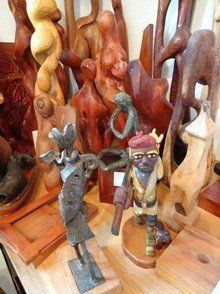
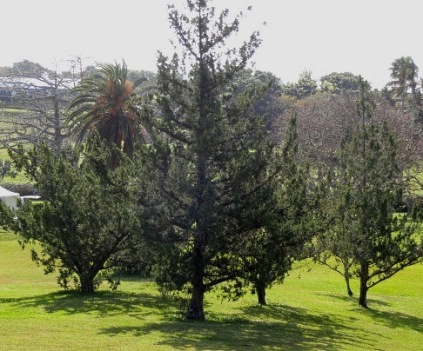
By the time Admiral Sir George Somers finally arrived in Jamestown, Virginia, in the spring of 1610, the "starving time" had reduced the approximately 500 colonists of the previous autumn to a barely living 60. the third supply shipment launched the previous May by the parent company, the Virginia Company of London, had become a calamity after the fleet of nine ships ran into a tempest (the same that inspired Shakespeare), sending Somers' ship, the Sea Venture , into the reefs of Bermuda.
Luckily for him (but most unluckily for the others), his ship held most of the supplies bound for Jamestown, which the crew managed to salvage without a single loss of life. The ship, however, was a total loss and the crew could expect to be stranded for a while.
Somers probably could not have picked a better island to be marooned on. The uninhabited island had plenty of wild pigs and cahow birds to eat and enough rainfall to drink. But perhaps most importantly, it offered them a way home--Bermuda cedar.  Juniperus bermudiana is not exactly a pretty tree. When young, they are cone-shaped with sparse branches and needles somewhat reminiscent of a Charlie Brown Christmas. As they age, the greyish bark bleaches in the sun, while the branches and trunk gnarlify into occasionally monstrous positions.
Juniperus bermudiana is not exactly a pretty tree. When young, they are cone-shaped with sparse branches and needles somewhat reminiscent of a Charlie Brown Christmas. As they age, the greyish bark bleaches in the sun, while the branches and trunk gnarlify into occasionally monstrous positions.
Cutting into one, however, reveals something quite different. Like a choice butcher's loin, the pith of the tree is vibrantly red and soft. But it's the sweet, earthy aroma released that instantly charms. Even better, the same aroma naturally repels moths, fleas, mildew and rot, making the wood a particular favorite for furniture.
The danger of such popularity was not lost on the colonists, who enacted cedar protection laws as early as 1627. However, it was World War II that almost wiped out the species, when the instillation of an American naval base unintentionally introduced a series of fungi which decimated the population. In just 10 years, 90 percent of Bermuda Cedar trees were dead.
What's left is jealously guarded and nurtured by the government and environmental groups, but also by the island's thriving artist community. Chesley Trott, sculptor, wood carver, and resident artist at the Bermuda Arts Centre at Dockyard, has been shaping Bermuda cedar since he was a boy. Retiring from teaching after 39 years, Trott now dedicates himself full-time to the art, if only, as he told me during my visit to his studio a month ago, "to feed my wife."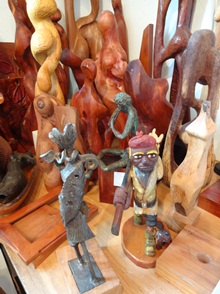
You can smell the cedar even before entering the room, and once inside, it envelops you like a narcotic, again making you search for the right words to describe the scent--musty, spicy, smoky, humidory? Around you, every surface of the studio tumbles over with cedar sculptures, ranging from quaint figures, evocative of Bermuda and island culture (his biggest sellers), to curvaceous abstract forms (his personal favorites).
Trott can generally be found chipping away at several projects at once, sometimes commissions from individuals or simply to sell in the shop. Unless a big deadline is coming, he's more than happy to put down his tools for a few moments and chat with visitors. It doesn't take long before the teacher comes out.
"Cedar's such a beautiful wood when it's finished," he told Look Bermuda several years ago, "Objects that you make out of it have a good start at being beautiful just [from] the material itself." And he's right. There is indeed a twinkle in the grains of his work, which along with the narcotic sway of the aroma, makes you draw out your wallet without noticing. The fact that he invites you to touch the sculptures, adds yet another, almost erotic tactile attraction. Had I been a richer journalist, I would not have escaped the seduction of one of Trott's abstracts, which range between $100 and $10,000.
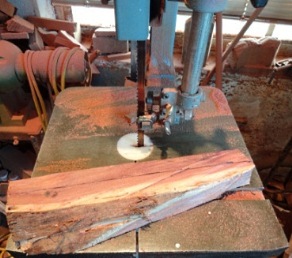 Like most carvers of Bermuda cedar, Trott obtains his stash from gifts or direct purchasing, as finding the wood naturally and collectably is exceedingly rare. Like many, he does worry about Bermuda cedar becoming extinct and hastens to point out that he only uses Bermuda cedar that has been dead at least three years, the length of time it takes for the wood to dry out completely.
Like most carvers of Bermuda cedar, Trott obtains his stash from gifts or direct purchasing, as finding the wood naturally and collectably is exceedingly rare. Like many, he does worry about Bermuda cedar becoming extinct and hastens to point out that he only uses Bermuda cedar that has been dead at least three years, the length of time it takes for the wood to dry out completely.
Across the Great Sound in Hamilton, Bermuda's capital, Milton Hill focuses his cedar carving talent on miniature model ships. Predominantly, his work hearkens back to the colonial days of ship travel, with exquisitely detailed 17th and 18th-century sloops, pilot gigs, galleons, and replicas of the Sea Venture among his repertoire. In 2012, his work earned him a lifetime achievement award by The Bermuda Arts Council.
If you are lucky enough to be standing in the The Windjammer II Gallery, inside the Fairmont Hamilton Princess hotel, marveling at his works, and he steps into the shop at the same moment, he'll be happy to talk about his work in his modest, rumbly voice. Perhaps just as interesting is how he uses his art to work with youth in De Boys' Day Out Club, an organization dedicated to the "emotional and social wellbeing of young men" and developing them in "courageous men, committed husbands, caring fathers and productive citizens." But of course, feel free ask about Bermuda cedar too. Just be ready for the full story.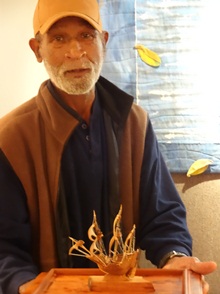
As beautiful a keepsake as they are, wood carvings are not the only way to bring home Bermuda cedar. Lili Bermuda, a perfumery in St. George, sells a Bermuda cedarwood eau de toilette for men-- "a warm woody blend of cedarwood, bergamot, lavender, rosemary and juniper." Add $35 to the $65 price tag and, it'll even come it is own, hand-carved Bermuda cedar box.
But perhaps the best way to experience the cedar is simply to spend as much time as possible around it. Going "native" in Bermuda doesn't just mean sucking up the clear white sunlight and azure ocean breezes, but also the cedar itself. It's not the sun almondizing the skin of long term residents, it's the cedar.
It must have got into Sir George Somers too, during the 10 months he and his crew bound cedar trees into two new ships, the Deliverance and the Patience. It must also be why, as legend says, he ordered his heart buried in Bermuda, while the rest was shipped back to England, pickled in whisky, in a cedar cask.
Returning home after 10 years abroad, Mike Dunphy now gets his travel fix in 800-word portions.
Photography by Mike Dunphy